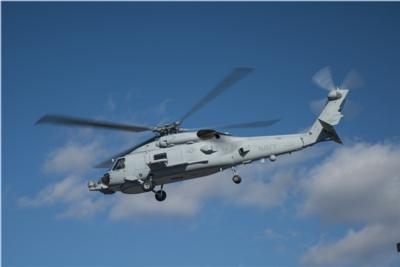Mon, Nov 17, 2014
MH-60R Sub Hunters Have Flown More Than 250,000 Hours
The U.S. Navy received its 200th submarine-hunting MH-60R "Romeo" helicopter from Lockheed Martin following a patch signing with Helicopter Maritime Strike Squadron Seven-Two (HSM-72). The cornerstone of the U.S. Navy's anti-surface and anti-submarine operations, MH-60R helicopters have flown more than 250,000 hours in operation with the Fleet, providing increased surveillance and situational awareness.

"We are proud to continue supporting the U.S. Navy by delivering a multi-role aircraft with a game-changing sensor suite that shifts the advantage from the submarine to the helicopter," said Dan Spoor, vice president of Aviation and Unmanned Systems for Lockheed Martin's Mission Systems and Training business. "As surface and submarine warfare becomes increasingly complex, the MH-60R's capabilities are unmatched in identifying, locating, tracking and prosecuting these threats."
Manufactured by Sikorsky Aircraft Corp and provided with advanced mission systems and sensors by Lockheed Martin, the MH-60R employs a modular design, which refers to the ability to modify weapon systems to match specific mission requirements. The modularity gives this single platform the agility to provide greater surveillance and flexibility to the Fleet, tailored for the mission. Aboard the MH-60R, sensor data is integrated into actionable information for the three-member crew. The mission systems compile data from onboard and offboard sensors to create an integrated picture that enhances decision-making.
Secondary missions include search and rescue, vertical replenishment, naval surface fire support, logistics support, personnel transport, medical evacuation, and very high frequency, ultra high frequency link communication relay.
The U.S. Navy is projected to acquire 291 MH-60R helicopters. The Lockheed Martin-Sikorsky team has also delivered five of 24 aircraft to the Royal Australian Navy and began production for the Royal Danish Navy, which will acquire nine aircraft.
(Image provided by Lockheed Martin)
More News
DETRESFA (Distress Phrase) The code word used to designate an emergency phase wherein there is reasonable certainty that an aircraft and its occupants are threatened by grave and i>[...]
"General aviation is at the forefront of developing and introducing innovative technologies that will transform the entire aviation industry..." Source: Kyle Martin, Vice President>[...]
Direct Straight line flight between two navigational aids, fixes, points, or any combination thereof. When used by pilots in describing off-airway routes, points defining direct ro>[...]
Aero Linx: Women in Corporate Aviation Women in Corporate Aviation support individuals seeking career advancement and professional development in the business aviation industry. Me>[...]
“We would like to thank the many volunteers that help throughout the year to pull off the event, as well as the several reviewers, judges, and SURVICE staff that provide team>[...]
 ANN's Daily Aero-Term (04.26.24): DETRESFA (Distress Phrase)
ANN's Daily Aero-Term (04.26.24): DETRESFA (Distress Phrase) Aero-News: Quote of the Day (04.26.24)
Aero-News: Quote of the Day (04.26.24) ANN's Daily Aero-Term (04.27.24): Direct
ANN's Daily Aero-Term (04.27.24): Direct ANN's Daily Aero-Linx (04.27.24)
ANN's Daily Aero-Linx (04.27.24) Aero-News: Quote of the Day (04.27.24)
Aero-News: Quote of the Day (04.27.24)



